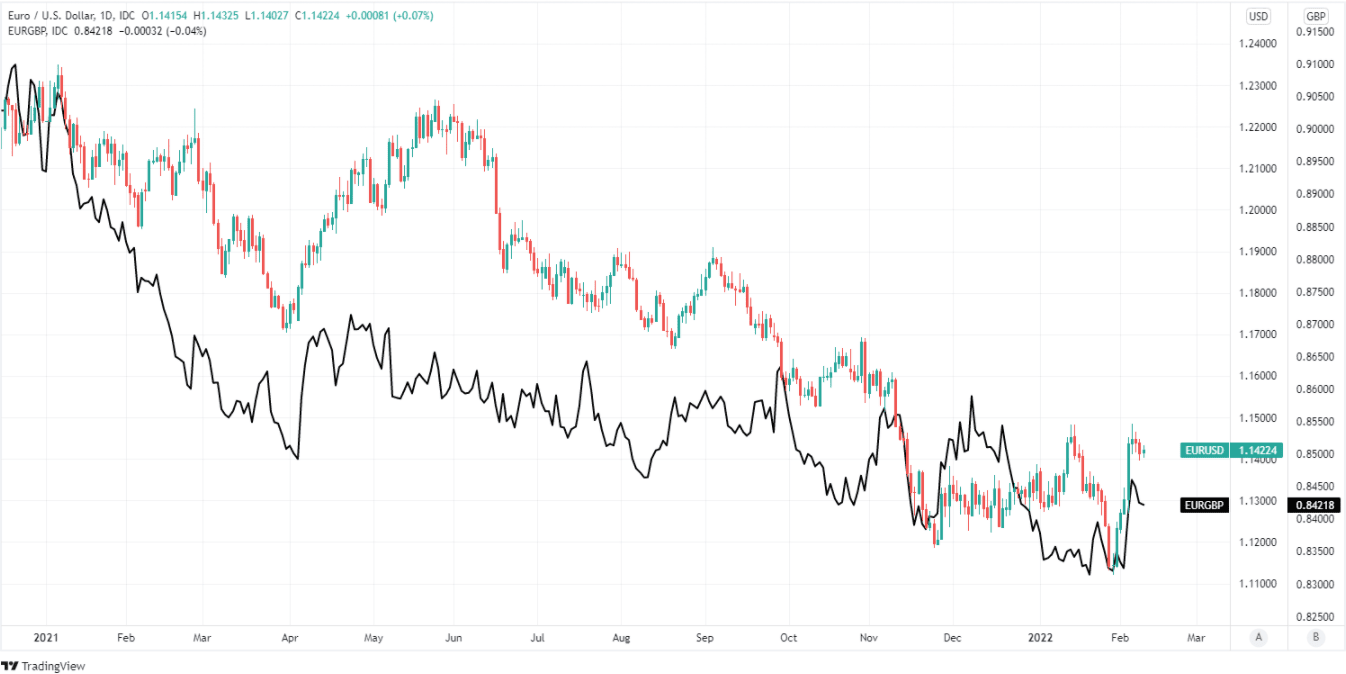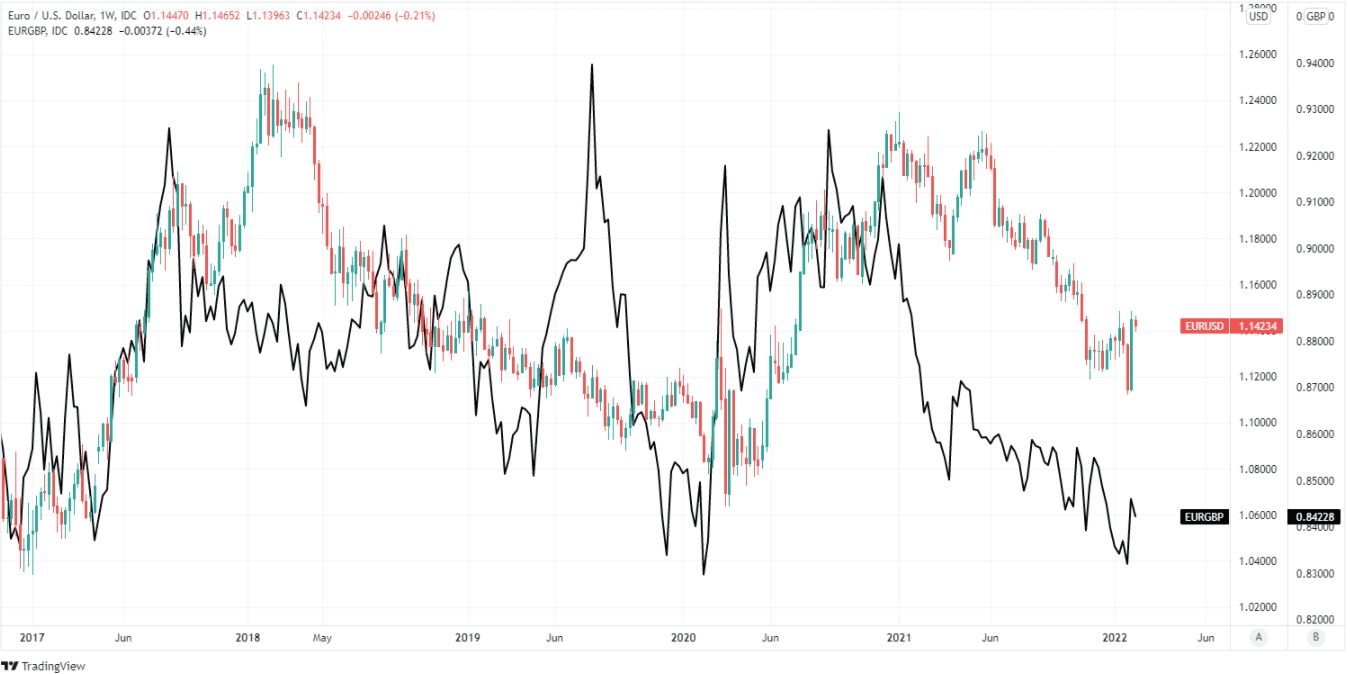EUR/USD May Have Bottomed but Upside Seen as Limited
- Written by: James Skinner
-
- EUR/USD likely reached its lowest ebb in January
- Could be bottoming amid signs of ECB policy shift
- But Fed policy & U.S. CPI limit scope for recovery

Image © Adobe Images
The Euro to Dollar rate may have reached its lowest ebb during January and could now be in the process of bottoming out in the wake of February’s European Central Bank (ECB) monetary policy decision, although some strategists say EUR/USD’s scope for recovery is likely to be very limited.
Europe’s single currency fell close to the round number of 1.11 in January, its lowest level for almost two years, as it bore the brunt of a strengthening Dollar due in part to a widespread perception that the ECB would be unlikely to respond this year to recent developments in Eurozone inflation.
But last week’s monetary policy decision transpired to be a watershed moment for the Euro after President Christine Lagarde acknowledged upside risks to the bank’s forecasts and declined to repeat an earlier assurance that Eurozone interest rates would be “highly unlikely” to rise at all this year.
“Prior to last week, it has been our view that the theme of ECB policy normalisation would likely lift the EUR in the second half of this year. Clearly this has now been brought forward,” says Jane Foley, head of FX strategy at Rabobank.
“We had anticipated that EUR/USD would trend down towards 1.10 around the middle of the year as the Fed initiated its programme of rate hikes and that the currency pair would then start to turn higher. The ECB’s hawkish tilt forces us to re-evaluate this view. Certainly EUR/USD 1.10 seems further away than previously anticipated,” Foley also said in a Tuesday research briefing.
Above: Euro-Dollar rate shown at daily intervals alongside EUR/GBP.
- EUR/USD reference rates at publication:
Spot: 1.1400 - High street bank rates (indicative band): 1.1000-1.1085
- Payment specialist rates (indicative band): 1.1300-1.1350
- Find out more about market-beating rates and service, here
- Set up an exchange rate alert, here
ECB forecasts had envisaged Eurozone inflation would be likely to peak around January before declining steadily through the year, enabling the bank to be more patient in its approach to normalising its monetary policy settings than counterparts in other jurisdictions like the UK, U.S., New Zealand and Norway to name just a few.
But January’s data showed the annual inflation rate inching higher again and led President Lagarde to warn in February’s press conference that a more protracted period of elevated price pressures is likely ahead, necessitating along the way a more flexible stance of policy from the ECB.
“The ECB’s shift from monetary policy divergence to monetary policy convergence is significant and the EUR faces a grind higher over the coming weeks as the FX markets adjust,” says Eimear Daly, an FX and emerging market macro strategist at Barclays.
“We stick to our EURUSD forecast of 1.19 by end-2022 and see the EUR gaining most traction vs currencies where domestic inflation dynamics suggest lagging monetary tightening, e.g., JPY and CHF. We continue to recommend long EURJPY with a target of 137,” Daly and colleagues said on Monday.
{wbamp-hide start}
{wbamp-hide end}{wbamp-show start}{wbamp-show end}
Last week’s press conference prompted a wave of forecast upgrades from economists and analysts, many of whom now look for the ECB to begin lifting its -0.50% deposit rate during the final months of the year before returning the benchmark to the zero percent level some time in early 2023.
But President Lagarde’s Monday testimony to the Committee on Economic and Monetary Affairs made clear that this is a long way from being assured.
“In a few weeks, the March ECB staff projections will provide an updated assessment, taking the most recent data into account. This will help the Governing Council better appraise the implications of the surprisingly high December and January inflation figures for the medium-term outlook,” she told the European parliament’s committee.
“Obviously, in our assessment of the inflation outlook, we have to bear in mind that demand conditions in the euro area do not show the same signs of overheating that can be observed in other major economies. This increases the likelihood that the current price pressures will subside before becoming entrenched, enabling us to deliver on our two per cent target over the medium term,” she also said on Monday.
Above: Euro-Dollar rate shown at weekly intervals alongside EUR/GBP.
Secure a retail exchange rate that is between 3-5% stronger than offered by leading banks, learn more.
President Lagarde emphasised that at least some of the factors currently lifting inflation - such as high energy prices - will be a burden for companies and households that likely combats current above-target inflation pressures by reducing investment and spending.
She also flagged that medium and longer-term expectations of inflation in the Eurozone remain stable near the ECB’s symmetric two percent target.
This kind of assessment potentially means the ECB will judge that only minimal further changes to its monetary policies are likely to be necessary, changes that could ultimately be limited to a faster or more comprehensive winding down of the bank’s two quantitative easing programmes.
“We expect that the market has priced in too much policy tightening for the ECB on a 1 year view. Assuming some of this is unwound, the EUR could struggle to maintain an upward trend vs. the USD particularly in view of the recent strength of US labour data and when US January CPI inflation data is expected to print 7.3% y/y,” Rabobank’s Foley said on Tuesday.
“Consequently, in the near-term, we see risk that EUR/USD continues to shy away from breaking about the 1.1485 area with the USD finding support from US inflationary fears. However, the ECB’s tilt will have awakened EUR bulls and strengthened the view that EUR/USD has the potential to end the year at a more robust level. Over the next few days we will be re-evaluating our EUR/USD forecasts,” Foley also said.







